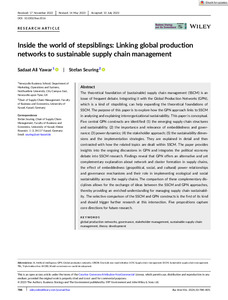| dc.date.accessioned | 2024-02-09T09:10:46Z | |
| dc.date.available | 2024-02-09T09:10:46Z | |
| dc.date.issued | 2023-07-31 | |
| dc.identifier | doi:10.17170/kobra-202402099552 | |
| dc.identifier.uri | http://hdl.handle.net/123456789/15448 | |
| dc.description.sponsorship | Gefördert im Rahmen des Projekts DEAL | |
| dc.language.iso | eng | |
| dc.rights | Namensnennung-Nicht-kommerziell 4.0 International | * |
| dc.rights.uri | http://creativecommons.org/licenses/by-nc/4.0/ | * |
| dc.subject | global production networks | eng |
| dc.subject | governance | eng |
| dc.subject | stakeholder management | eng |
| dc.subject | sustainable supply chain management | eng |
| dc.subject | theory development | eng |
| dc.subject.ddc | 330 | |
| dc.title | Inside the world of stepsiblings: Linking global production networks to sustainable supply chain management | eng |
| dc.type | Aufsatz | |
| dcterms.abstract | The theoretical foundation of (sustainable) supply chain management (SSCM) is an issue of frequent debate. Integrating it with the Global Production Networks (GPN), which is a kind of stepsibling, can help expanding the theoretical foundations of SSCM. The purpose of this paper is to explore how the GPN approach links to SSCM in analysing and explaining interorganizational sustainability. This paper is conceptual. Five central GPN constructs are identified: (1) the emerging supply chain structures and sustainability; (2) the importance and relevance of embeddedness and governance; (3) power dynamics; (4) the stakeholder approach; (5) the sustainability dimensions and the implementation strategies. They are explained in detail and then contrasted with how the related topics are dealt within SSCM. The paper provides insights into the ongoing discussions in GPN and integrates the political economy debate into SSCM research. Findings reveal that GPN offers an alternative and yet complementary explanation about network and cluster formation in supply chains, the effect of embeddedness (geopolitical, social, and cultural) power relationships and governance mechanisms and their role in implementing ecological and social sustainability across the supply chains. The comparison of these complementary disciplines allows for the exchange of ideas between the SSCM and GPN approaches, thereby providing an enriched understanding for managing supply chain sustainability. The selective comparison of the SSCM and GPN constructs is the first of its kind and should trigger further research at this intersection. Five propositions capture core directions for future research. | eng |
| dcterms.accessRights | open access | |
| dcterms.creator | Yawar, Sadaat Ali | |
| dcterms.creator | Seuring, Stefan | |
| dc.relation.doi | doi:10.1002/bse.3516 | |
| dc.subject.swd | Nachhaltigkeit | ger |
| dc.subject.swd | Supply Chain Management | ger |
| dc.subject.swd | Netzwerkmanagement | ger |
| dc.subject.swd | Entwicklungstheorie | ger |
| dc.subject.swd | Stiefgeschwister | ger |
| dc.type.version | publishedVersion | |
| dcterms.source.identifier | eissn:1099-0836 | |
| dcterms.source.issue | Issue 2 | |
| dcterms.source.journal | Business Strategy and the Environment | eng |
| dcterms.source.pageinfo | 788 - 805 | |
| dcterms.source.volume | Volume 33 | |
| kup.iskup | false | |


